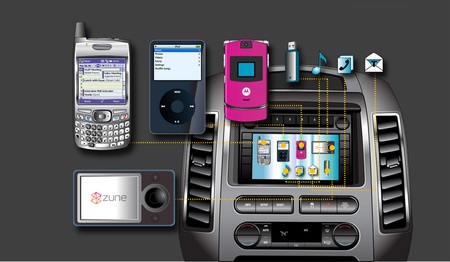Distracted driving has become one of the U.S. Department of Transportation's banner issues under secretary Ray LaHood's tenure, with agencies launching safety programs and awareness campaigns aimed at preventing the practice. Last week, LaHood stepped into new territory by recommending that cars be built to automatically disable potentially distracting electronic devices when in motion.

The new guidelines would seem to be of special comfort to pedestrians, cyclists, and even motorcyclists who have long observed the trend of cars getting safer for their occupants but more dangerous for everyone else. "When automakers employ 'Infotainment Systems Engineers,' like Ford does," says BikePortland's Jonathan Maus, "that should raise a red flag."
Automakers are scrambling to find newer and fancier ways for drivers to stay connected behind the wheel, ostensibly to meet consumer demand. At the most recent Consumer Electronics Expo, Mercedes-Benz debuted their in-dash system that supports some Facebook functions even while the car is in motion, in what Maus calls a "disturbing trend":
Automakers, scared that their vehicles can't compete with consumers' growing adoration of smartphones and other devices, now offer all sorts of phone-like conveniences on-board. The result? More distraction, more crashes, more deaths and injuries.
The National Transportation Safety Board had already recommended a set of anti-distracted driving measures, including outlawing the use of any electronic device -- hands-on or hands-free -- while driving. But the new guidelines, which are voluntary and unenforceable, represent only a cautious next step in making it harder to drive distracted. Gone is the ban on hands-free devices, for example, and the new rules would only apply to built-in electronics, leading some to expect that drivers would find after-market ways to stay connected.
David Coursey, a contributor to Forbes, supports the guidelines but thinks they don't get to the root of the problem:
We should concentrate on technology that notices when a driver is actually distracted and diverts their attention back to driving. We should also create better user interfaces for automobile electronics that improve driver attention rather than divert it.
For their part, manufacturers say that they have held themselves to "an evolving set of self-imposed electronics guidelines for a decade" according to The Washington Post. Robert Strassburger, vice president of vehicle safety for the Alliance of Automobile Manufacturers, told the Post that “any task behind the wheel that takes more than two seconds to complete or can’t be completed in a couple of brief chunks would be locked out or would be prohibited,” what they call the "two-second rule."
According to research, two seconds is still too long. NHTSA estimates that a driver whose attention is taken off the road for two seconds becomes twice as likely to be in a crash. Sending or receiving a text message takes 4.6 seconds.





